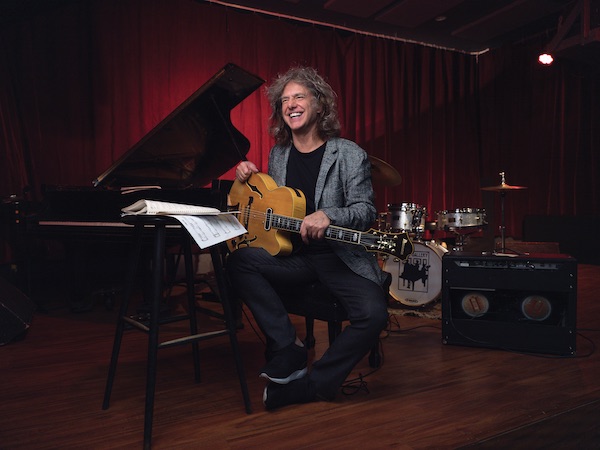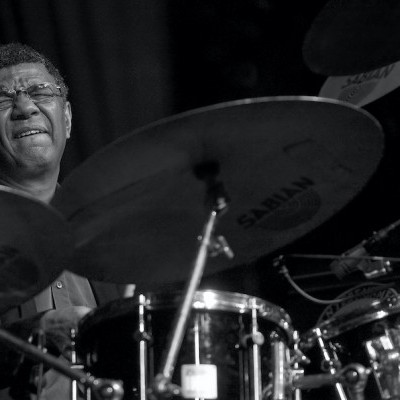Oct 28, 2025 10:47 AM
In Memoriam: Jack DeJohnette, 1942–2025
Jack DeJohnette, a bold and resourceful drummer and NEA Jazz Master who forged a unique vocabulary on the kit over his…

Over the course of his career, Pat Metheny has edged closer to the orchestral vision reflected on his latest release, From This Place.
(Photo: Jimmy & Dena Katz)“We all thought it was going to be a quartet record, and then Pat told us that he was hearing something bigger on it,” Sánchez said during a phone interview. “If we had known that there was going to be an orchestra there, we would have completely changed our plan. But since we were recording as a quartet, we were playing exactly the way that we would if we were playing live. Then [Pat had] the brilliant idea to bring in arrangers, who tailored the [orchestrations] to what we played. It was very interesting—I’ve never seen anything like that before.”
Initially, Metheny had planned to write all of the orchestrations himself. It made sense: By the time of the first session, he already had penned the 10 original songs in the program, decided what tempos he wanted and assigned solos, keeping the strengths of each band member in mind. The arrangements were notated in the music program Sibelius, and the guitarist was forming notions about what the orchestra could add to his compositions. As always, Metheny was meticulously prepared.
“Whatever people’s perception of my thing is—yes, I do play the guitar—my main gig for 45 years has always been as bandleader, or bandleader-slash-composer. I write 90 percent or more of the notes that we’re going to play,” he said. “My job has mostly been about finding context for the musicians that I admire to sound great in. For me, it’s been a process of understanding what that is.”
Metheny’s first sketches for the orchestrations “were fine,” he said. “They were kind of straight up and down, right down the middle of what we were playing. Then I thought, ‘I’m missing an opportunity here. There are people who do [orchestrations] 48 out of 52 weeks a year. So, why not bring those voices in?’”
In particular, he wanted the voices of Gil Goldstein and Alan Broadbent, two formidable pianists with impressive credits as arrangers and sidemen. Both rose to prominence in the 1990s for their arranging work on high-profile jazz or traditional pop albums, and both went on to win Grammys for their arrangements. Importantly, both “know how to play rhythm, how to play in time, how to make stuff groove,” Metheny said. In other words, they offered more than mere sweetening.
Metheny divided the tunes to be orchestrated between the two arrangers—keeping one and change for himself—and assigned Goldstein “America Undefined,” the epic 13-minute composition that would become the opening track. “I gave Gil the super-hard things,” Metheny commented, noting the arranger’s skill in working with rhythmic complexities. “And there’s some really hard music in there.”
Goldstein wouldn’t disagree. “The first piece was the hardest,” he said, speaking by phone from his Long Island home. “I went to [Pat’s] studio in his New York apartment, and when he played it for me, I understood absolutely nothing. I couldn’t get what time signature it was in, and the pitches were eluding me. It seemed so sophisticated, and I was getting more and more into a panic as the track went on. Then the end part came—that long vamp. It was pretty empty, with just the band, like a trio, not even with Pat in it. It was just a blank canvas.”
To fill that canvas, Goldstein began with a subtle sweep of violins supporting the quartet as the individual players developed Metheny’s engagingly chromatic theme. By mid-tune the orchestra has taken up this theme, now punctuated with electronic reverberation, rattling percussion, distant voices and clanging bells. Despite the gathering momentum, however, the expected triumphant final cadence never arrives; instead, the instruments stop speaking to each other and scatter, and the musical statement dissolves in a free outro. Undefined, yes—and brilliant.
“Honestly, [making this album] is kind of a dream come true for me,” Goldstein said. Strong praise, given that he and Metheny have played together on scores of projects since they first met as students at the University of Miami in the early 1970s.
“The first three days I was in Florida, I heard Jaco Pastorius play at a club in Fort Lauderdale, and then I heard Pat play in a class on jazz composition,” Goldstein recalled. “My whole experience of the world changed in those three days.”
Upon graduating, Goldstein soon established himself as a successful player in New York, working with the likes of guitarist Pat Martino and saxophonist Lee Konitz, among others, including the up-and-coming Metheny. “Gil was the original piano player in my original band, and I had to decide between him and Lyle [Mays],” Metheny said, referring to The Pat Metheny Group, formed in 1977. “It was a tough decision.”
Goldstein recalls that Metheny had complimented his arranging skills in their early Miami days—a foreshadowing, perhaps, of the turn his career would later take. In 1983, Goldstein joined the Gil Evans Orchestra as its regular pianist, and in that rich musical environment, he started to write for horn sections. Before long, he was scoring and arranging for film and TV projects. It was around this time that Metheny, noting Goldstein’s growing success as an arranger, asked if he also wrote for strings, suggesting that Goldstein might orchestrate Secret Story.
“I stupidly said that I haven’t done so much [with strings], which was the wrong answer,” Goldstein said, ruefully. “He hired the great Jeremy Lubbock to orchestrate it, and I ended up playing those arrangements on tour. But I was always very sad that I reacted with such a bad instinct. So, I’ve always been waiting for this [new] record.”
For the album’s title track, Metheny turned to Broadbent for the arranger’s refined understanding of what strings can do harmonically. “Alan got the tunes that were more in the Nelson Riddle or Leonard Rosenman area,” he said, referring to two of the most prominent orchestrator/composers of the mid-20th century.

Jack DeJohnette boasted a musical resume that was as long as it was fearsome.
Oct 28, 2025 10:47 AM
Jack DeJohnette, a bold and resourceful drummer and NEA Jazz Master who forged a unique vocabulary on the kit over his…

D’Angelo achieved commercial and critical success experimenting with a fusion of jazz, funk, soul, R&B and hip-hop.
Oct 14, 2025 1:47 PM
D’Angelo, a Grammy-winning R&B and neo-soul singer, guitarist and pianist who exerted a profound influence on 21st…

To see the complete list of nominations for the 2026 Grammy Awards, go to grammy.com.
Nov 11, 2025 12:35 PM
The nominations for the 2026 Grammy Awards are in, with plenty to smile about for the worlds of jazz, blues and beyond.…

Jim McNeely’s singular body of work had a profound and lasting influence on many of today’s top jazz composers in the U.S. and in Europe.
Oct 7, 2025 3:40 PM
Pianist Jim McNeely, one of the most distinguished large ensemble jazz composers of his generation, died Sept. 26 at…

Drummond was cherished by generations of mainstream jazz listeners and bandleaders for his authoritative tonal presence, a defining quality of his style most apparent when he played his instrument unamplified.
Nov 4, 2025 11:39 AM
Ray Drummond, a first-call bassist who appeared on hundreds of albums as a sideman for some of the top names in jazz…






